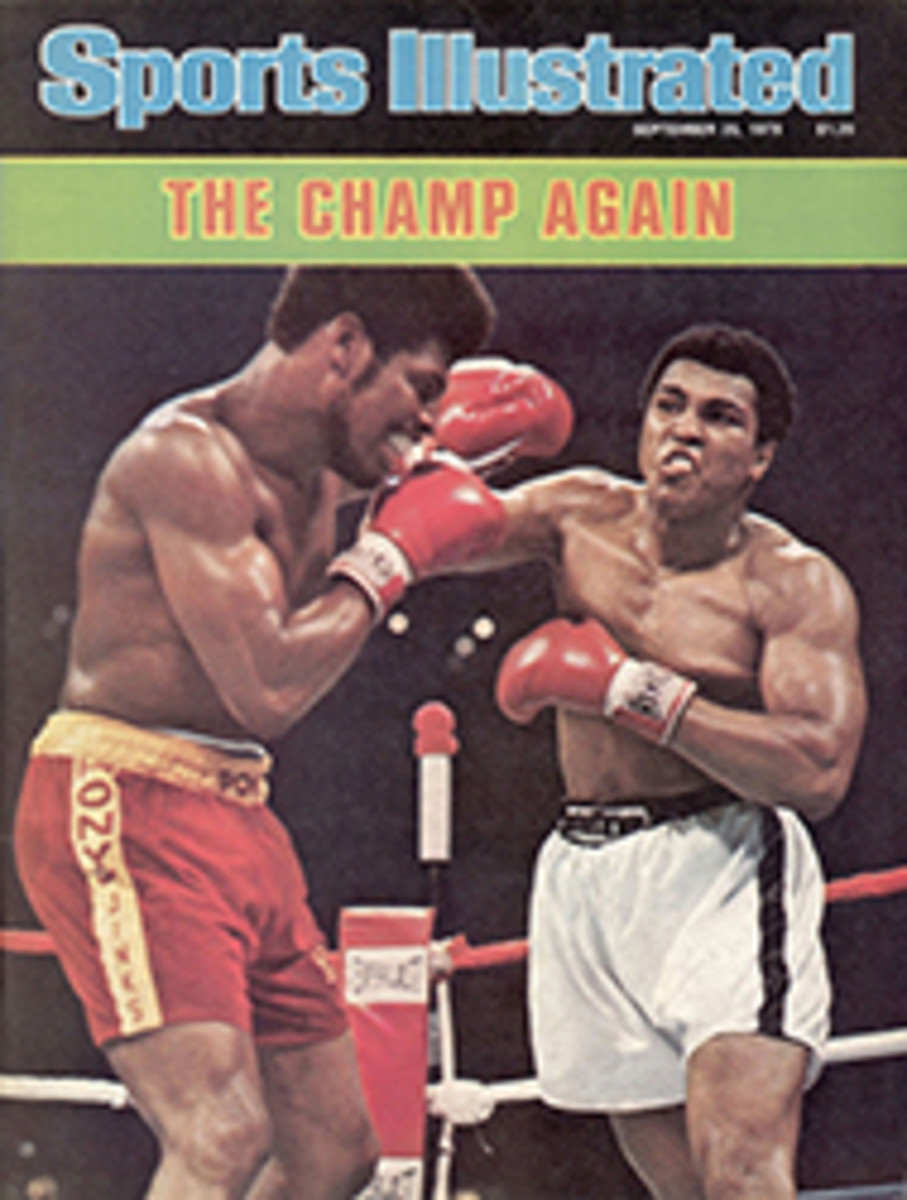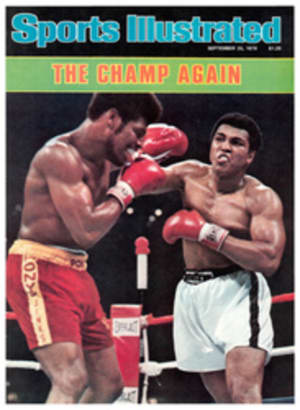
Jumping to a thrilling conclusion
Shortly before the U.S. was to defend its World Three-Day Event title in Lexington, Ky., Bruce Davidson's Irish Cap, perhaps the best eventing horse in the country and the mount he rode to gold medals in the 1974 World Championships and the 1976 Olympics, went lame. With only a young, relatively inexperienced horse to take his place, there was speculation that Davidson, although free to compete as an individual, might not be nominated to the team, but when the list came out last Wednesday his name was on it, with that of Might Tango, a 7-year-old, 17-hand gray gelding thoroughbred.
This past weekend, the team that almost did not make the team made history as Davidson became the first person ever to win the Individual World Championship twice in a row. For Might Tango, the victory was comparable to a junior high school quarterback leading USC to victory in the Rose Bowl, and for a while there at the end of the most demanding speed and endurance test ever incorporated into a world championship, the horse looked as if the effort had been too great.
"There were rumors that Might Tango was in shock," Davidson said after Saturday's cross country, "but that's what they were—rumors. I'm really proud of my horse. He was very tired, but he carried on. Most other horses would have stopped."
Many other horses did stop, defeated by the cross-country course and the heat. After Saturday's competition, only 26 of the 47 starters remained, four of the seven teams had fallen by the wayside and several riders had been taken to the hospital—one, it was feared, at first, with a broken neck.
For the spectators the eventing went more smoothly. As early as 6 a.m. on the first day, the stands of the new $27 million, 1,032-acre Kentucky Horse Park were filled with fans wrapped in blankets waiting for the dressage, the first event of the four-day competition—an extra day was required because of the number of horses—to begin. Despite the 90° heat on Friday, the spectators remained staunchly in their seats through the 30-minute morning and afternoon breaks. By Saturday, the third day, the flabbergasted sponsors saw a crowd of 70,000 moving decorously about a setting that might have been in England or in half a dozen other places in Europe. Blue, red and yellow striped tents had been set up among handsome slate-roofed buildings. More than 100 tiny shops strung along grassy walkways sold 19th-century prints, harness brasses, folding chairs, shooting sticks, Hermès scarves, boots, hats, umbrellas, Irish tweed, English leathers—and Kentucky fried chicken.
The crowds were dressed in every sort of attire, from shorts to saris, some carrying picnic baskets and folding chairs, others with toddlers and dogs in tow. They spoke a dozen languages, and interpreters had been rounded up for all of them. The only oversight, one wag complained, was the lack of an interpreter to translate American English into English English. The omission was felt most keenly by HRH, the Duke of Edinburgh, who, as president of the Federation Equestre Internationale, presided over the championships and was mystified to find a local paper describing his movements through the crowds as "ghostlike" and likening him to a "Bowie Kuhn honchoing a sporting event."
Eventing, or combined training, was originally intended to test the fitness of cavalry officers. The three events in modern eventing are dressage, the speed and endurance trial, and stadium jumping, the mastery of which—by the same horse and rider—demands the utmost in control, strength and spirit. An eventing horse is required to split his personality. For dressage, he must be calm and entirely willing to be controlled, to answer the commands of his rider, which are transmitted so subtly that, ideally, they are imperceptible to the onlooker. The horse is required to perform 20 movements in a set sequence in 7½ minutes. On the following day, the horse is expected to charge fearlessly over the countryside in a test like last week's, which is divided into four parts: two obstacle-free timed tests called Roads and Tracks, separated by an 11-jump steeplechase and followed by the most difficult phase of all, the cross country.
At the end of the dressage phase in Lexington, the news, for Americans, was good. Mike Plumb, riding 45th in the 47-horse field, turned in the best score, 50.2, to beat out riders from Great Britain and Holland.
If the crowd had been attentive to this first stage of the championships, it was transfixed by the second. The speed and endurance tests are the heart of the Three-Day Event, both because they demand extreme effort from horse and rider, and because they offer the greatest spectacle to an audience. The 33 jumps on the 4½-mile cross-country course, each built of different species of native Kentucky woods, were so skillfully integrated into the terrain that in many places they seemed a natural part of the rolling countryside. Some were ordinary enough; others decidedly were not. Reactions of those walking the course, as riders may do without their horses, ranged from interest to horror.
The most spectacular obstacle was Old Fort Lexington, a three-element combination that included a cluster of small cabins followed by a 3'7" bank topped by a two-foot stockade. Although its difficulty was more psychological than real, it took out an unexpected number of riders and sent an Argentinian, Captain Carlos Rawson, to the hospital. When asked how he would take the Ditch and Rails that followed, Kuranjo Saito, the single entry from Japan, who has spent the last two years in this country solely to train for the event, said simply, "Not get so far." Those who did (including Saito) then faced a Normandy bank with a 5'11" drop into water, which took an even greater toll. But the most treacherous obstacle of all proved to be the Serpent, a triple combination with two turns over three fences, further complicated by water and angles. By this point the horses that had cleared the 22 preceding obstacles were tiring—if not, indeed, exhausted—and the Serpent proved a disaster area. At one stage, seven riders in a row fell, were retired or eliminated, including Story Jenks of the U.S., who had held an early lead, and Britain's Christopher Collins and Lucinda Prior-Palmer. Prior-Palmer went on to finish, but Plumb was less fortunate. Coming into the Footbridge, a relatively simple fence two jumps before the Serpent, Plumb's horse Laurenson refused. The late afternoon sun, suddenly reflected in the water at the right and shortest part of the Footbridge, apparently frightened him. Plumb took the horse successfully over the left side, but his rhythm and pace had been broken. At the third and most difficult element of the Serpent, spectators watched in stunned silence as Laurenson refused three times to take the jump, eliminating Plumb, and almost certainly the U.S., from contention.
At the end of the day, only eight riders had clear cross-country runs, and 19 were no longer in contention. Of the seven teams entered, Holland, Argentina, Great Britain and New Zealand were out, leaving Canada, the U.S. and Germany, in that order. Only Canada, with a substantial lead, had all four team members still in the running. Its first rider in the cross-country, Juliet Graham Bishop, on her 14-year-old gray gelding Sumatra, had been the second contestant to complete the course. She had reported that speed was dangerous, and Canadian Coach B. K. Ishoy ordered the rest of his team to take it "cool and careful." It was clearly the right advice.
Leading the individual riders was Davidson on Might Tango. He was followed by 26-year-old Ralph Hill, the junior member of the U.S. team and the sleeper of the championships. Hill, riding in his first international competition, was on Sergeant Gilbert, a 9-year-old gelding he raised from a colt. He had a clean round and finished the cross country only 20 penalty points behind Davidson.
Although this should have been reason for rejoicing, U.S. Coach Jack LeGoff made clear his dissatisfaction with the course. "This is the biggest course I have ever seen in my life," he said. "It is the biggest course anywhere. The fences are too big, there are too few places to relax between, and too many jumps together. There has been a lot of damage out there today on that battlefield."
Few disagreed. Most criticism was leveled at the Serpent. "The jump asked too many questions of a horse that was tired," said Prince Philip. "And here you had a classic problem of a jump being built in April to be used in September. The bank had not had time to settle and harden. After the first few horses went over, the base turned into a foot of soft loam."
The heat and humidity of an unseasonably hot September were also blamed for the heavy toll. Going into the final day, only 26 horses were eligible for the stadium show-jumping test, a half-mile course intended simply to ensure that a horse is still able, and willing, to perform for its rider after the grueling endurance phase. The expected traps of a pure show-jumping course—tall fences, odd angles, difficult stridings—were generally missing, although the Lexington show-jumping layout was also considered more difficult than most.
While stadium jumping contributes less to the overall score than the two previous phases, medals are often won and lost here. This year Ireland's lone rider, John Watson, rode his 11-year-old bay gelding Cambridge Blue into the ring in sixth place and emerged minutes later, after a clear round, in second, to take the individual silver medal behind Davidson. In fairness to countries that cannot field teams, the FEI has decided that the privilege of hosting the world championships should belong to the nation of the individual winner. But since a country may not have the championships back to back, last week the honor passed, with the silver medal, to Ireland, Watson's home country. The bronze medal went to the German, Helmut Rethemeier.
The teams also experienced some juggling of medals as Rethemeier took his 9-year-old Holstein gelding Ladalco through a clean round of stadium jumping, claiming the silver for his team, while the Americans collected the bronze. As for the team gold, it remained solidly on this side of the Atlantic, but it was Canada's.
PHOTO
Top-scoring Canadian Elizabeth Ashton and Sunrise take the jump that took so many competitors.

